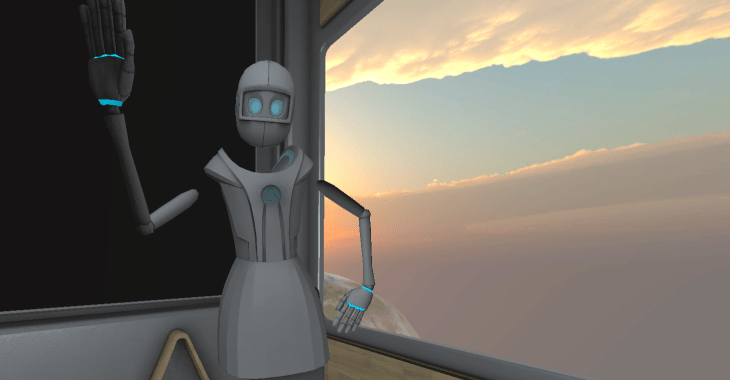“Let’s take a selfie in front of that window with the galaxy,” I say to an excitable robot that looks like Wall-E’s svelte girlfriend EVA. On the other end of the Internet from TechCrunch’s SF headquarters is Eric Romo. The CEO is also jacked into Altspace, the virtual reality chat room his startup built. Romo teleports over to my preferred spot by the starship’s window.
Cameras on our computers and Leap motion trackers affixed to our headsets translate our mannerisms and gesticulations into the virtual world. I cock my head sideways and throw up a triumphant fist just like in most of my meatspace selfies. Our VR self portrait looks remarkably accurate.
This is my first interview done over VR. Already I can feel wisps of my identify coming across the wire. It’s reasonable to suspect I might be taking a lot more meetings on the virtual plane in the near future.
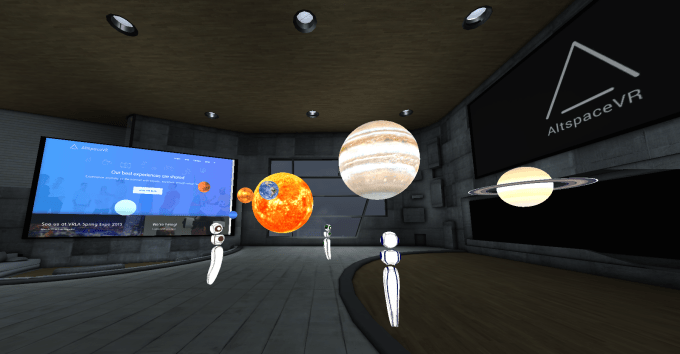
Back in 1994, intrepid explorers of a digital frontier banded together to commune and communicate. They weren’t the first, but the fact that they didn’t have to build it themselves allowed a much wider range of perspective to flow through the new medium. Computer novices joined expert coders.
These were the chat rooms of America Online.
Now, the scene is playing out again in Altspace. Backed by Google Ventures, the VR communication platform lets dozens of people from anywhere in the world share a virtual space.
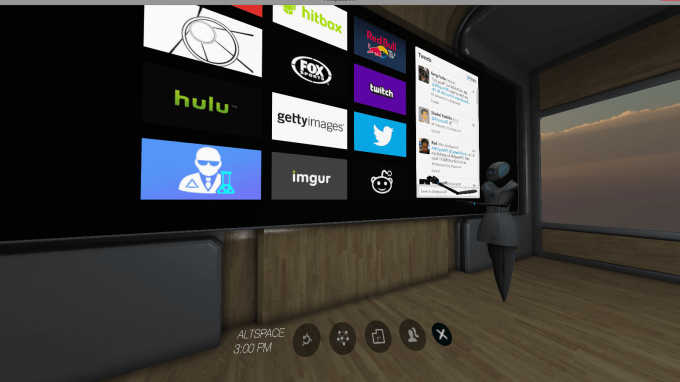
Watch Internet videos with friends in VR
Holodeck, v1
After several weekend-long experiments, Altspace is permanently thrusting open the doors of its VR chat room. There’s now a place for headset-wearers in their bedrooms and basements to congregate 24/7/365. Talk with friends or strangers. Teleport around spacious villas. Watch Netflix or YouTube on a jumbotron. Play life-sized chess. Take a selfie. It’s Second Life from the first person.
“People cluster together,” Romo says. “If you design the physics of the interaction correctly, people follow the patterns they do in real life.” Binaural, directional audio means you can tell if someone behind you is talking, and you’ll hear their voice fade if you wander away. And through a new partnership with SensoMotoric Instruments, AltspaceVR will soon be able to track your eye movements so you can squint at someone when you’re skeptical, or look up at someone with puppy-dog eyes inside VR.
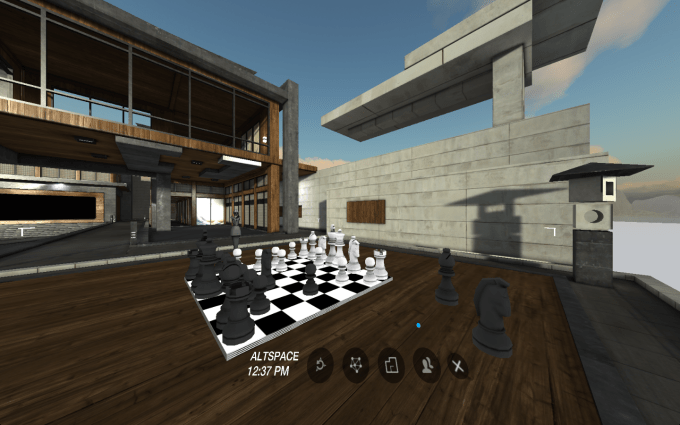
JavaScript games like chess can be fitted with 3D models and be played in VR
When Mark Zuckerberg pounced on Oculus, he discussed its potential not just for gaming, cinema and computing, but for social interaction. Facebook can make you feel metaphorically closer to your friends and family. Virtual reality could make you actually feel like you’re sitting next to them. Altspace is a big step toward that dream.
AltspaceVR was founded in 2013 and has since absorbed $5.2 million in funding from investors, including Google Ventures, Formation 8, Dolby, Tencent, Rothenberg Ventures, Haystack, Promous, Maven, Startcaps, Lux, Promus, Foundation, and SV Angel. Led by Romo, a former SpaceX propulsion lead analyst, its 15-person team is trying to build a social software bridge between the fragmented VR headset makers. AltspaceVR runs on a MacBook Pro with a suped-up graphic chip, meaning you won’t need a hard-core gaming PC to run it.
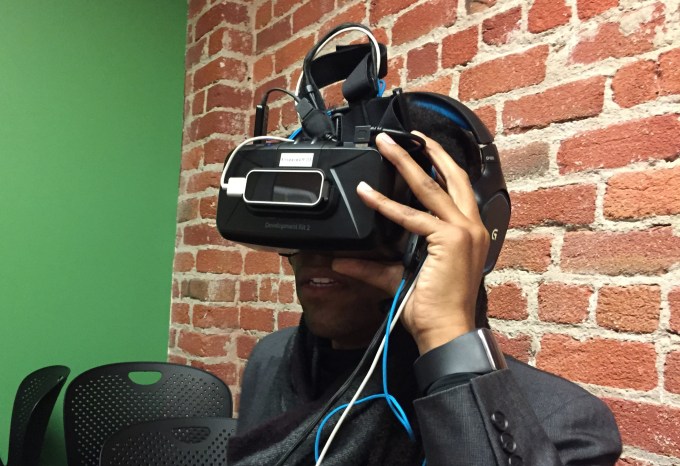
AltspaceVR’s head of developer and community relations Bruce Wooden wearing a headset with Leap Motion attached
Despite some rough edges and a limited set of things to do, beta users have shown a remarkable willingness to stay in AltspaceVR. At one point, a group watched all of Terminator 2. The average usage over a weekend-long chat room test has been 25 minutes, “which is just crazy, crazy good,” says Romo, noting Netflix’s average session is around 20 minutes. Twenty percent of users in the last test spent over two hours inside the land of make-believe.
And that’s really the goal — a new medium for creativity where the physical world’s limitations don’t apply. At one point, Romo loads what I can only describe as VR drugs. Like a hallucination or something out of Hitchhikers Guide To The Galaxy, Romo presses a button and a school of fish start swimming through the air around us. “This is literally a webpage. This is JavaScript,” he beams as we move a few life-sized chess pieces around.
Some simple code and a few 3D models, and AltspaceVR’s platform lets anyone create a virtual-reality experience multiple people can enjoy at once. Offering a canvas lets developers concentrate on their art.
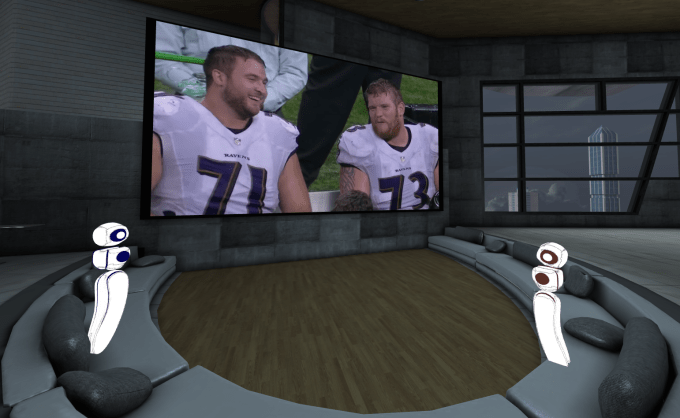
Wherever, Together
What form their imaginations take remains to be seen. While early adopters might gleefully muck about inside, AltspaceVR will need compelling activities or extraordinarily vivid digital face-to-face communication to eventually keep the laymen tuned in.
 Watching eSports and other video content has been popular, but Romo imagines intellectual symposiums and celebrity meet-and-greets. AltspaceVR sticks you in a robot avatar for now, but could one day let you walk around in your own skin if you’ve been VR-scanned by a booth like the xxArray.
Watching eSports and other video content has been popular, but Romo imagines intellectual symposiums and celebrity meet-and-greets. AltspaceVR sticks you in a robot avatar for now, but could one day let you walk around in your own skin if you’ve been VR-scanned by a booth like the xxArray.
Security might not let the screaming fangirls near Justin Bieber in real life, but there’s no danger in letting them crowd around and ask questions virtually. Charging for these kinds of events or otherwise allowing users to pay for more premier experiences could turn AltspaceVR into a business.
Not being in the right place at the right time causes lots of problems and inconveniences — from long-distance relationships to traffic-filled commutes, rural isolation to scarce access to art and entertainment. Virtual Rome won’t be built in a day. But bit by bit, startups like AltspaceVR are constructing ways for us to be wherever with whomever we want.

My Altspace selfie with its CEO Eric Romo (I’m on the right)
